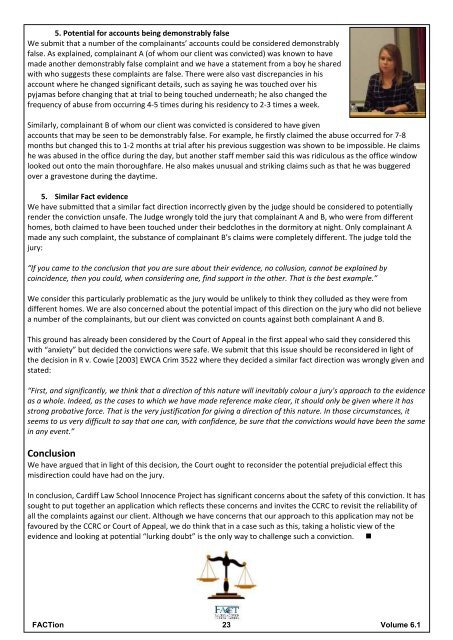FACTion-6.1-web-version
FACTion-6.1-web-version
FACTion-6.1-web-version
Create successful ePaper yourself
Turn your PDF publications into a flip-book with our unique Google optimized e-Paper software.
5. Potential for accounts being demonstrably falseWe submit that a number of the complainants’ accounts could be considered demonstrablyfalse. As explained, complainant A (of whom our client was convicted) was known to havemade another demonstrably false complaint and we have a statement from a boy he sharedwith who suggests these complaints are false. There were also vast discrepancies in hisaccount where he changed significant details, such as saying he was touched over hispyjamas before changing that at trial to being touched underneath; he also changed thefrequency of abuse from occurring 4-5 times during his residency to 2-3 times a week.Similarly, complainant B of whom our client was convicted is considered to have givenaccounts that may be seen to be demonstrably false. For example, he firstly claimed the abuse occurred for 7-8months but changed this to 1-2 months at trial after his previous suggestion was shown to be impossible. He claimshe was abused in the office during the day, but another staff member said this was ridiculous as the office windowlooked out onto the main thoroughfare. He also makes unusual and striking claims such as that he was buggeredover a gravestone during the daytime.5. Similar Fact evidenceWe have submitted that a similar fact direction incorrectly given by the judge should be considered to potentiallyrender the conviction unsafe. The Judge wrongly told the jury that complainant A and B, who were from differenthomes, both claimed to have been touched under their bedclothes in the dormitory at night. Only complainant Amade any such complaint, the substance of complainant B’s claims were completely different. The judge told thejury:“If you came to the conclusion that you are sure about their evidence, no collusion, cannot be explained bycoincidence, then you could, when considering one, find support in the other. That is the best example.”We consider this particularly problematic as the jury would be unlikely to think they colluded as they were fromdifferent homes. We are also concerned about the potential impact of this direction on the jury who did not believea number of the complainants, but our client was convicted on counts against both complainant A and B.This ground has already been considered by the Court of Appeal in the first appeal who said they considered thiswith “anxiety” but decided the convictions were safe. We submit that this issue should be reconsidered in light ofthe decision in R v. Cowie [2003] EWCA Crim 3522 where they decided a similar fact direction was wrongly given andstated:“First, and significantly, we think that a direction of this nature will inevitably colour a jury's approach to the evidenceas a whole. Indeed, as the cases to which we have made reference make clear, it should only be given where it hasstrong probative force. That is the very justification for giving a direction of this nature. In those circumstances, itseems to us very difficult to say that one can, with confidence, be sure that the convictions would have been the samein any event.”ConclusionWe have argued that in light of this decision, the Court ought to reconsider the potential prejudicial effect thismisdirection could have had on the jury.In conclusion, Cardiff Law School Innocence Project has significant concerns about the safety of this conviction. It hassought to put together an application which reflects these concerns and invites the CCRC to revisit the reliability ofall the complaints against our client. Although we have concerns that our approach to this application may not befavoured by the CCRC or Court of Appeal, we do think that in a case such as this, taking a holistic view of theevidence and looking at potential “lurking doubt” is the only way to challenge such a conviction. •<strong>FACTion</strong> 23 Volume <strong>6.1</strong>


